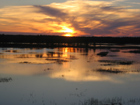 | | Sunset at Seda River | | Floodplain monitoring Surveys of the night birds have been taking place in floodplains for almost a month now. It is one of the most important actions of the LIFE Nature project “Restoration of Latvian Floodplains for EU priority species and habitats”, in order to monitor bird breeding density changes. First priority is given to the project sites where restoration works are planned this year or already started.  | | Sunset at Seda River | Floodplain monitoring Surveys of the night birds have been taking place in floodplains for almost a month now. It is one of the most important actions of the LIFE Nature project “Restoration of Latvian Floodplains for EU priority species and habitats”, in order to monitor bird breeding density changes. First priority is given to the project sites where restoration works are planned this year or already started. Inventories are planned on regular basis – first round is taking place and second round will be done during the June, taking the same counting routes. Experts will follow this scheme for three years in consecutive order. Demonstrative data with fixed changes of breeding bird’s numbers will be a result of these inventories – to demonstrate the effectiveness of management measures taken in the project.  | | Fullymoon night at May | Counts of night-birds are taking place after sunset, experts are accurately noticing whether conditions at the start and finish of survey and marking the bird species at the route-map. Registered bird species are: corncrake, spotted crake, great snipe, river warbler, grasshopper warbler and several others, which are active singing during the night time. Project regional coordinators and other bird experts do surveys. During the daytime searching for corncrakes is ineffective because of bird’s behaviour. Then they are feeding or snoozing without vocalization and seeing of corncrake is next to impossible. Situation with other night birds is similar - they are singing after night has set in - because of natural adaptation against competition of huge singing noise what do daytime active birds make. Andris Klepers, public awareness coordinator | 






